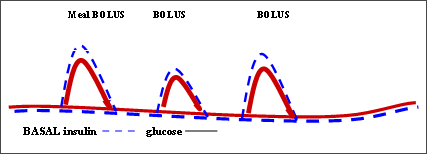Share:
How do pumps work and what makes them different?
- Insulin pumps are about the size of a pager. They are worn all the time.
- The pump is set to deliver an infusion of basal (background) insulin all the time, over 24 hours. Different basal rates are set for different times of day depending on your needs.
- You give a certain amount of insulin for each meal or snack according to how much carbohydrate is in the food. This is called a bolus.
- As of 2007 most pumps have a ‘calculator’ feature that will help decide the right dose for you, based on your individual guidelines. They also have special blood glucose meters that send the results directly to the pump with wireless, infra-red technology.
- Only rapid or fast acting insulin is used in the pump.
- The insulin pump delivers insulin through a thin plastic tube (called a cannula) inserted under the skin (like your injections). This insulin infusion set is changed every 2-3 days.
| Acting like your pancreas means … | Why a pump does it better |
| Basal insulin is released into blood stream continuously, very small amounts (<1.0 unit every hour) every few minutes. Just enough to match your glucose needs between meals. |
It uses only rapid acting insulin in tiny (0.05 unit) increments all the time. Variable rates are programmed to match your natural glucose: insulin pattern during the night and day. |
|
The insulin rate slows down if activity increases and/or your glucose becomes lower. The insulin rate rises if needed – e.g. stress, during sick day. |
You can easily change to a temporary basal rate at any time. Because you are using only rapid acting insulin, the insulin level can be changed rapidly to match your needs better. You can prevent lows and highs more easily. |
| Giving a meal bolus whenever you eat or drink. |
Insulin is always handy & easy to give at the touch of a button. No need to take an injection. You change the infusion set about once every 3 days, so you inject once every three days, not with every meal. |
| Giving a meal bolus that matches CHO intake and the glycemic index of the food. | A bolus calculator helps you decide the right insulin dose. It uses your individual guidelines and it does the math. |
| Be able to sense what your blood glucose is and deliver just the right amount of insulin to keep the glucose within target range. | Your blood glucose meter or the continuous glucose sensor will send a real-time result directly to the pump with wireless, infra-red technology. You may use this information to make a correction. |
Important points to consider
- Insulin pumps cost approximately $6400 and pump supplies are an extra cost of $200-$250/month (above the cost for insulin and test strips)
- A number of insurance companies cover the cost of the insulin pump and/or pump supplies.
- Self-monitoring of blood glucose (blood glucose testing) at least four to six times daily is vital to succeed with insulin pump therapy. This is true for all intensive therapy plans.
-
You should check out all of your options for each pump. Examples include:
-
- Animas – www.animas.ca
-
-
Other references include:
-
- Diabetes Mall – www.diabetesnet.com
- Insulin Pumpers of Canada – www.insulin-pumpers.ca
-
Continuous Subcutaneous Insulin Infusion (CSII) - Insulin Pump







